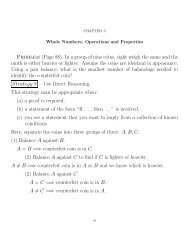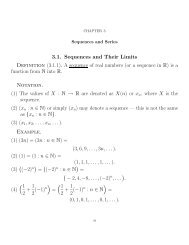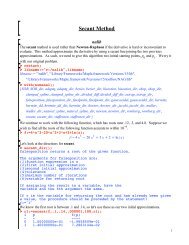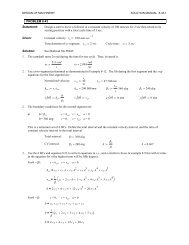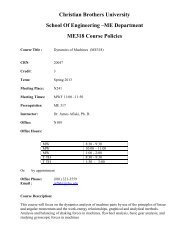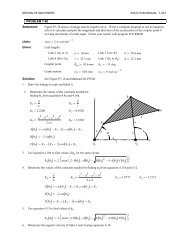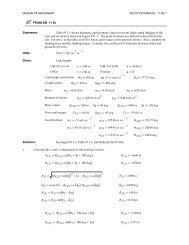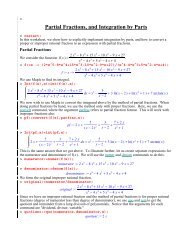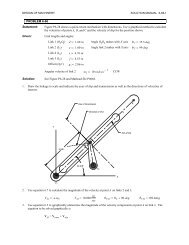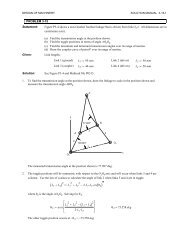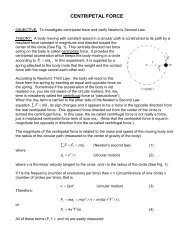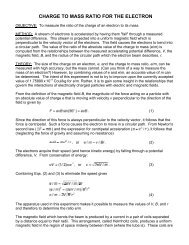4.1. Limits of Functions Definition (4.1.1). Let A â R. A point c ... - CBU
4.1. Limits of Functions Definition (4.1.1). Let A â R. A point c ... - CBU
4.1. Limits of Functions Definition (4.1.1). Let A â R. A point c ... - CBU
Create successful ePaper yourself
Turn your PDF publications into a flip-book with our unique Google optimized e-Paper software.
CHAPTER 4<strong>Limits</strong><strong>4.1.</strong> <strong>Limits</strong> <strong>of</strong> <strong>Functions</strong><strong>Definition</strong> (<strong>4.1.</strong>1). <strong>Let</strong> A ✓ R. A <strong>point</strong> c 2 A is a cluster <strong>point</strong> <strong>of</strong> A if8 > 0, 9 at least one <strong>point</strong> x 2 A, x 6= c, 3 |x c| < .Note. c may or may not be a member <strong>of</strong> A.Example.(1) The set <strong>of</strong> cluster <strong>point</strong>s <strong>of</strong> (0, 1) is [0, 1].(2) A = {0, 1} has no cluster <strong>point</strong>s.Theorem (<strong>4.1.</strong>2 — Sequential Characterisation <strong>of</strong> a Cluster Point).c is a cluster <strong>point</strong> <strong>of</strong> A ✓ R () 9 a sequence (a n ) in A 3 a n 6= c 8 n 2N and lim(a n ) = c.Pro<strong>of</strong>.(=)) c a cluster <strong>point</strong> <strong>of</strong> A =) 8n 2 N,9 a n 2 A, a n 6= c, 3 |a n c| < 1 n .⇣ 1Since lim = 0, lim(a n ) = c by Theorem 3.1.10.n⌘((=) 9 a sequence (a n ) in A\{c} 3 lim(a n ) = c.Then, given >), 9 K 2 N 3 8 n K, |a n c| < . ⇤71
72 4. LIMITSExample.(1) Every <strong>point</strong> <strong>of</strong> [a, b] is a cluster <strong>point</strong> <strong>of</strong> (a, b).(2) N has no cluster <strong>point</strong>s.n 1o(3)2 : n 2 N has only 0 as a cluster <strong>point</strong>.n(4) Finite sets have no cluster <strong>point</strong>s.(5) Every <strong>point</strong> <strong>of</strong> [a, b] is a cluster <strong>point</strong> <strong>of</strong> [a, b] \ Q.<strong>Definition</strong>. <strong>Let</strong> A ✓ R, f : A ! R, and c be a cluster <strong>point</strong> <strong>of</strong> A. Wesay limx!cf(x) = L (or lim x!c f = L or f(x) ! L as x ! c) if8 ✏ > 0 9 > 0 3 x 2 A and 0 < |x c| < =) |f(x) L| < ✏.Note. IfCalculator Visualisationworks in the definition and 1 apple , the 1 also works since0 < |x c| < 1 =) 0 < |x c| < .lim f(x) = L if 8 y-window [L ✏, L + ✏] 9 an x-window [c , c + ] 3 thex!cgraph enters the window on the left and only exits on the right.
<strong>4.1.</strong> LIMITS OF FUNCTIONS 73Theorem (<strong>4.1.</strong>5). If f : A ! R and c is a cluster <strong>point</strong> <strong>of</strong> A, then fcan have at most (not “only”) one limit at c.Pro<strong>of</strong>. Suppose lim f(x) = L and lim f(x) = M. <strong>Let</strong> ✏ > 0 be given.x!c x!cSince lim f(x) = L,x!c9 1 > 0 3 x 2 A and 0 < |x c| < 1 =) |f(x) L| < ✏ 2 .Since limx!cf(x) = M,9 2 > 0 3 x 2 A and 0 < |x c| < 2 =) |f(x) M| < ✏ 2 .<strong>Let</strong> = min 1, 2 . Then, for x 2 A and 0 < |x c| < ,|L M| = |(L f(x)) +(f(x) M)| apple |f(x) L| +|f(x) M| < ✏ 2 + ✏ 2 = ✏.Since ✏ is arbitrary, |L M| = 0 =) L = M. ⇤Theorem (<strong>4.1.</strong>6). <strong>Let</strong> f : A ! R and c be a cluster <strong>point</strong> <strong>of</strong> A. Thenlim f(x) = L () 8 ✏-neighborhood V ✏(L) <strong>of</strong> L, 9 a -neighborhood V (c)x!c<strong>of</strong> c 3 if x 6= c is any <strong>point</strong> in V (c) \ A, then f(x) belongs to V ✏ (L).Example.(1) limx!c(3x) = 3c.Pro<strong>of</strong>. Given ✏ > 0.[To find > 0 3 0 < |x c| < =) |3x 3c| < ✏.] Now|3x 3c| = 3|x c| < ✏ () |x 3| < ✏ 3 .Take = ✏ . Then 0 < |x c| < =) |3x 3c| < ✏. ⇤3(2) limx!ca = a.Pro<strong>of</strong>. Given ✏ > 0, |a a| = 0 < ✏ 8 > 0. ⇤
74 4. LIMITS(3) (a) f(x) = x2, x 6= 0. lim f(x) = 0.x x!0Pro<strong>of</strong>. <strong>Let</strong> ✏ > 0 be given.Now x2x0 = |x 0| for x 6= 0, so= ✏ works. Then 0 < |x 0| < =) x2x(x 2(b) g(x) =x , x 6= 010, x = 0 . lim g(x) = 0.x!0The value <strong>of</strong> g(0), if there is one, does not matter.(4) lim x 2 = c 2 .x!cPro<strong>of</strong>. Given ✏ > 0.⇥We want |x2c 2 | < ✏ or |x + c| · |x c|| {z } | {z }? Controllable bychoice <strong>of</strong> , say apple 1. ⇤ Take apple 1. Then0 < ✏. ⇤< ✏. Make an initial|x c| < apple 1 =) 1 < x c < 1 =) 2c 1 < x + c < 2c + 1 =)x + c < 2c + 1 apple 2|c| + 1 and (x + c) < 1 2c apple 2|c| + 1 =)Then for apple 1,|x + c| < 1 + 2|c| [giving control over the ? factor].|x 2 c 2 | = |x + c| · |x c| < (2|c| + 1)|x c| < ✏ (= |x c|
<strong>4.1.</strong> LIMITS OF FUNCTIONS 75Technique (works sometimes).If |f(x) L| = |g(x)| · |x c|, choose apple 1 to get|x c| < 1 =) |g(x)| < M,so |f(x) L| < M|x c| < ✏ if |x c| < ✏ M also.n✏oThen = min 1, works.MExample.x 3 1(5) limx! 1 2x + 1 = 2.Pro<strong>of</strong>. Given ✏ > 0. [Need to separate out |x + 1| since x ! 1.]x 3 12x + 12 = x3 1 4x 22x + 1= x3 4x 32x + 1= x2 x 32x + 1Choose apple 1 3 , so |x + 1| < 1 3 =) 4 3 < x < 2 3 (avoiding 12 ).Then |x 2 x 3| apple |x| 2 + |x| + 3 < 169 + 4 3 + 3 = 559 .8Also,3 < 2x < 4 3 =) 5 3 < 2x + 1 < 1 3 =)|2x + 1| > 1 3 =) 1|2x + 1| < 3. Then, for apple 1 3 ,x 2 x 32x + 1Take= min· |x + 1|· |x + 1| < 55553✏· 3|x 1| = |x 1| < ✏ (= |x 1|
76 4. LIMITS(6) limx!0p1 + x = 1.Pro<strong>of</strong>. Given ✏ > 0.| p 1 + x 1| = ( p 1 + x 1) ·p 1 + x + 1p 1 + x + 1=xp 1 + x + 1=1p 1 + x + 1|x 0|.Pickapple 1. Then|x 0| < 1 =) 1 < x < 1 =) 0 < x + 1 < 2 =)1p 1 + x + 1|x 0| < |x 0| < ✏ if apple ✏ also.Then = min{1, ✏} works. ⇤Lemma (A). <strong>Let</strong> f, g : A ! R and let c be a cluster <strong>point</strong> <strong>of</strong> A. If9 ↵ > 0 3 0 < |x c| < ↵ =) |f(x) L| apple |g(x)|,and if limx!cg(x) = 0, then limx!cf(x) = L.<strong>Let</strong>Pro<strong>of</strong>. Given ✏ > 0. Since limx!cg(x) = 0,9 1 > 0 3 0 < |x c| < 1 =) |g(x) 0| = |g(x)| < ✏.= min{ 1 , ↵}.Then x 2 A and 0 < |x c| < =) |f(x) L| apple |g(x)| < ✏. ⇤
<strong>4.1.</strong> LIMITS OF FUNCTIONS 77Theorem (<strong>4.1.</strong>8 — Sequential Criterion). <strong>Let</strong> f : A ! R and let c be acluster <strong>point</strong> <strong>of</strong> A. TFAE:(1) limx!cf(x) = L.(2) 8 sequence (x n ) in A 3 x n ! c, x n 6= c 8 n 2 N, the sequence f(x n )converges to L.Pro<strong>of</strong>.(1) =) (2). Given ✏ > 0 and (x n ) a sequence in A with lim(x n ) = c andx n 6= c 8 n 2 N. Since limx!cf(x) = L,9 > 0 3 x in A and 0 < |x c| < =) |f(x) L| < ✏.Since lim(x n ) = c,9 K 2 N 3 n K =) |x n c| < .Then 8 n K, x n in A and 0 < |x n c| < =) |f(x n ) L| < ✏.(2) =) (1). [A contrapositive argument.]Assume (1) is not true. ThenThen,9 ✏ 0 3 8 > 0 9 x in A with 0 < |x c| < and |f(x ) L| ✏ 0 .8n 2 N, 9 x n 2 A with 0 < |x n c| < 1 n and |f(x n) L| ✏ 0 .Then lim(x n ) = c by Theorem 3.1.10 and lim f(x n )true.6= L. Thus (2) is not⇤
78 4. LIMITSExample.x 3 1(5) [Redone] limx! 1 2x + 1 = 2.Pro<strong>of</strong>. <strong>Let</strong> (x n ) be a sequence in A 3 lim(x n ) = 1.Using limit properties <strong>of</strong> sequences,⇣ x31⌘lim = lim(x n) 3 12x + 1 2 lim(x n ) + 1 = ( 2( 1)3 1)11⇤Theorem (<strong>4.1.</strong>9 — Divergence Criterion). <strong>Let</strong> A ✓ R, f : A ! R, and ca cluster <strong>point</strong> <strong>of</strong> A.(a) limx!cf(x) 6= L () 9 a sequence (x n ) in A 3 x n 6= c 8 n 2 N,lim(x n ) = c, but lim f(x n ) 6= L.(b) f(x) does not have a limit at c () 9 a sequence (x n ) in A 3 x n 6=c 8 n 2 N, lim(x n ) = c, but f(x n ) does not converge.1Problem (Page 110 # 12b). lim p (x > 0) does not exist.x!0 x⇣ 1⌘Pro<strong>of</strong>. <strong>Let</strong> (x n ) = . Then lim(xn 2 n ) = 0.!⇣ 1⌘1But = q = (n) diverges. ⇤n 2 1n 2
<strong>4.1.</strong> LIMITS OF FUNCTIONS 79⇣ 1⌘Example. lim cos does not exist.x!0 xPro<strong>of</strong>. Recall cos ✓ = 1 for ✓ = 2n⇡ and cos ✓ = 1 for ✓ = (2n + 1)⇡.⇣ 1<strong>Let</strong> (x n ) =⇡ , 12⇡ , 1 ⌘ ⇣ 1⌘3⇡ , . . . = . (x n ) ! 0, butn⇡⇣cos 1 ⌘= cos ⇡, cos 2⇡, . . . = ( 1, 1, 1, 1, . . . ) diverges.x n⇣ 1Thus cos diverges.x⌘Another view:⇣1⌘! 0 and(2n 1)⇡cos✓ 11(2n 1)⇡◆ ! = cos(2n 1)⇡ = ( 1, 1, 1, . . . ) ! 1, while◆ ! = cos 2n⇡ = (1, 1, 1, . . . ) ! 1,✓ 1cos12n⇡i.e., we found two sequences converging to 0 that gave di↵erent limits.Homework Page 1110 # 9bc, 10ab, 12d, 15⇤
80 4. LIMITS4.2. Limit Theorems<strong>Definition</strong> (4.2.1). <strong>Let</strong> a ✓ R, let f : A ! R, and let c be a cluster <strong>point</strong><strong>of</strong> A. We say f is bounded on a neighborhood <strong>of</strong> c if 9 a -neighborhood V (c)and M > 0 3 |f(x)| apple M 8 x 2 A \ V (c).[Recall V (c) = (c , c + ).]Theorem (4.2.2). If A ✓ R, f : A ! R, and limx!cf(x) = L, then F isbounded on some neighborhood <strong>of</strong> c.Pro<strong>of</strong>. <strong>Let</strong> ✏ = 1. Since limx!cf(x) = L,9 > 0 3 x 2 A and 0 < |x c| < =) |f(x) L| < ✏ =)|f(x)| |L| apple |f(x) L| < 1 =) |f(x)| apple |L| + 1.If c 62 A, take M = |L| + 1.If c 2 A, take M = max{|f(c)|, |L| + 1}.<strong>Definition</strong> (4.2.3).(f + g)(x) = f(x) + g(x)(f g)(x) = f(x) g(x)(fg)(x) = f(x)g(x)(bf)(x) = bf(x)⇣ f⌘(x) = f(x) , g(x) 6= 0g g(x)⇤
4.2. LIMIT THEOREMS 81Theorem (4.2.4). <strong>Let</strong> A ✓ R, b 2 R, f, g : A ! R, and c be a cluster<strong>point</strong> <strong>of</strong> A. Further, suppose lim f(x) = L and lim g(x) = M. Thenx!c x!climx!climx!c(f + g)(x) = L + M(f g)(x) = L Mlimx!climx!cAlso, if M 6= 0 and g(x) 6= 0 8 x 2 A,limx!c⇣ fg(fg)(x) = LM(bf)(x) = bL⌘(x) = L M .Pro<strong>of</strong>. <strong>Let</strong> (x n ) be a sequence in A 3 lim(x n ) = c.Then lim f(x n ) = L and lim g(x n ) = M. Thuslim (f + g)(x n ) =lim f(x n ) + g(x n ) =lim f(x n ) + lim f(x n ) =L + MThus limx!c(f + g)(x) = L + M by Theorem <strong>4.1.</strong>8..etc.. ⇤
82 4. LIMITSExample.1(1) limx!0 xdoes not exist (DNE).Pro<strong>of</strong>. [Using the Archimedean Property.]1Suppose lim = L. Thenx!0 xf(x) = 1 xis bounded on some neighborhood <strong>of</strong> 0. Thus9 > 0 and M > 0 3 |f(x)| = 1 xapple M 8 x 2 ( , ).<strong>Let</strong> x 2 (0, ) =) 1 x apple M =) 1 Mapple x.By the Archimedean Property, 9 n 2 N 3 n > M. Then1n < 1 ⇣ 1⌘M < x < =) f = n apple M,na contradiction.⇤(2)x 2 + 2x 8lim=x!2 x 2 4(x + 4)(x 2)limx!2 (x + 2)(x 2) = lim x + 4x!2 x + 2 =lim x!2 (x + 4)lim x!2 (x + 2) = lim x!2 x + lim x!2 4lim x!2 x + lim x!2 2 =2 + 42 + 2 = 6 4 = 3 2 .(3) limx!cp(x) = p(c) for p(x) a polynomial.
4.2. LIMIT THEOREMS 83p(x)(4) limx!c q(x) = p(c) , p and q polynomials, q(c) 6= 0, in some neighborhood <strong>of</strong> cq(c)Theorem (4.2.6). <strong>Let</strong> A ✓ R, f : A ! R, and c be a cluster <strong>point</strong> <strong>of</strong>A. If a apple f(x) apple b 8 x 2 A\{c}, and if limx!cf(x) exists, thena apple limx!cf(x) apple b.Theorem (4.2.7 — Squeeze Theorem). <strong>Let</strong> A ✓ R, f : A ! R, and c bea cluster <strong>point</strong> <strong>of</strong> A. If f(x) apple g(x) apple h(x) 8 x 2 A\{c}, and ifthen limx!cg(x) = L.lim f(x) = lim h(x) = L,x!c x!cp ⇣ 1⌘Problem (Page 111# 11d). Find lim x sin .x!0 x 2⇣ 1⌘Solution. 1 apple sin apple 1 =)p x apple p ⇣ 1⌘x sin apple p xx 2 x 2p pSince lim x = lim x = 0,x!0 x!0p ⇣ 1⌘x sin = 0 by the Squeeze Theorem. ⇤x 2limx!0
84 4. LIMITSTheorem (4.2.9). <strong>Let</strong> A ✓ R, f : A ! R, and c be a cluster <strong>point</strong> <strong>of</strong>A. Iflim f(x) > 0 [resp. < 0]x!cthen 9 a neighborhood V (c) 3on A \ V (c).f(x) > 0 [resp. < 0]Homework Page 116 # 1c, 2c, 11b, 10 (extra credit)



